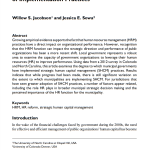Topic: Forms of Government

Strategic Human Capital Management in Municipal Government: An Assessment of the Degree of Implementation Practices
Growing empirical evidence supports the fact that human resource management (HRM) practices have a direct impact on organizational performance. However, recognition that the HRM function can impact the strategic direction and performance of public organizations has been a more recent shift. Local government represents a robust area to examine the capacity of government organizations to leverage their human resources (HR) to improve performance. Using data from a 2012 survey in Colorado and North Carolina, this article examines the degree to which municipal governments have implemented strategic human capital management (SHCM) practices. Results indicate that while progress had been made, there is still significant variation on the extent to which municipalities are implementing SHCM. For jurisdictions that have seen greater adoption of SHCM practices, a number of factors appear related, including the role HR plays in broader municipal strategic decision making and the perceived importance of the HR function for the municipality.
Cite as:
Jacobson, W. S., & Sowa, J. E. (2015). Strategic Human Capital Management in Municipal Government: An Assessment of Implementation Practices. Public Personnel Management, 44(3), 317–339. https://doi.org/10.1177/0091026015591283
…
Continued
Municipal Human Resource Management: Challenges and Innovative Practices in Turbulent Times
Municipal governments experienced many challenges brought on by the great recession of the late 2000s. Drawing on data from human resource directors in Colorado and North Carolina municipalities, this article examines the real-world implications of the economic recession on human resource management (HRM) practices, including the workforce-related challenges municipal governments face in a difficult economic climate and what HRM innovations were developed to respond. For challenges, funding was consistently the top response as well as recruiting and maintaining a motivated workforce. The bulk of the innovations were internally focused and reactionary in terms of responding to an immediate or current condition. Implications for practice are provided.
Cited as:
Jacobson, W. S., & Sowa, J. E. (2016). Municipal Human Resource Management: Challenges and Innovative Practices in Turbulent Times. State and Local Government Review, 48(2), 121–131. https://doi.org/10.1177/0160323X16658696
…
Continued
Form of Government Still Matters: Fostering Innovation in U.S. Municipal Governments
Using data on the adoption of e-government, reinventing government, and strategic practices, and
the Nelson and Svara (2010) typology of municipal government form, the authors investigate the
characteristics of municipal governments that are related to the implementation of innovative
practices. The authors find that higher innovation rates are associated with council-manager
governments—both with and without an elected mayor, higher population, greater growth,
lower unemployment, sunbelt location, and higher population density. Controlling for all other
variables, form of government (and variations within form) account for the greatest explanation
of the adoption of innovative practices in municipalities. The authors conclude that form of
government remains an important variable to consider when investigating local government
management and performance.
Cite as:
Nelson, K.L. and Svara, James H. (2012). Form of Government Still Matters: Fostering Innovation in U.S. Municipal Governments.
…
Continued
State Level Autonomy and Municipal Government Structure: Influence on Form of Government Outcomes
A number of recent studies have argued that municipal governments have so significantly modified elements of their form of government that it is now difficult to distinguish form. However, none of these studies considers the influence of state government on these choices. This study uses a comprehensive data set of U.S. municipal governments with populations of at least 10,000 and a data set of state legislative provisions related to form of government to investigate the influence of state law on municipal form of government choices. The findings demonstrate that state law is associated with some choices of government form and that structures that hybridize the council-manager and mayor-council forms of government are still relatively uncommon.
Cite As:
“State Level Autonomy and Municipal Government Structure: Influence on Form of Government Outcomes.” American Review of Public Administration, 41 (5): 542-561. K. L. Nelson, 2011.
…
Continued
